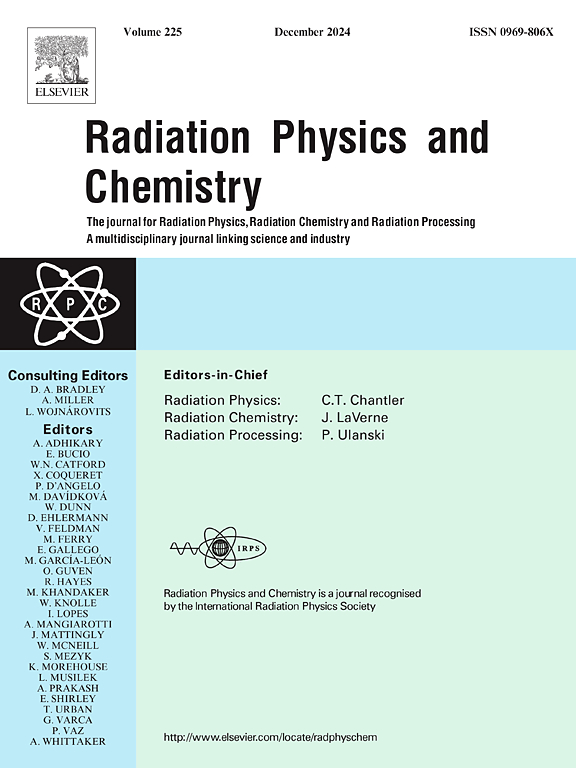Assessment of radiation hazards linked to lo-salt consumption in Kurdistan Region-Iraq
IF 2.8
3区 物理与天体物理
Q3 CHEMISTRY, PHYSICAL
引用次数: 0
Abstract
The current study involves 35 salt samples, including naturally occurring radioactive material (NORM) and its potential impact on public health. In Kurdistan-Iraq, retail outlets offer samples of both local and imported products. Samples consist of iodized salt, Himalayan pink salt (pink rock salt), lo-salt (less sodium salt), and sea salt. Assessment is conducted about the radiological risk associated with salt consumption, emphasizing internal exposure dose. The XRF spectrometer and gamma spectroscopy analysis (HPGe) are in use. For the radionuclides 226Ra and 232Th, the salt sample ranged from 0.4 ± 0.1 to 14.2 ± 2.3 and 0.9 ± 0.1 to 36.1 ± 1.4 Bq kg−1, respectively. The maximum activity level of 40K was discovered to be 45936 ± 8223 Bq kg−1 in the salt sample labeled S9, which was originally from the UK and included less sodium. Nevertheless, the sample, iodized white table salt, coded S35 (from Turkey), recorded the lowest values at 65.6 ± 4.8 Bq kg−1. It was noted that the NORM content range varied significantly among the salt samples. In contrast, the average radioactivity concentration ranges in salt samples exceeded the average range of the permissible values in the world by UNSCEAR for 232Th and 40K, at 45 and 412 Bq kg−1, respectively. The annual effective dose of 767 and 549 μSv would be the result of consuming the lo salt samples S9 and S10, respectively, assuming a daily salt intake of 6.4 g for adults. This exceeds the recommended level of effective 290 μSv , which is equivalent to (1 mSv ) for members of the general public. Samples of lo-salt less sodium (S9) and Himalayan pink salt (S12) were found to contain lead levels of 21.6 and 20.4 PPM (mg kg−1), respectively, which exceeded the national maximum contamination standard established by Food Standards Contamination and Codex. The daily salt consumption for people is assumed to be 6.4 g d−1. Potential risks of radiation exposure should be addressed in food legislation to mitigate the risk to public health.
伊拉克库尔德斯坦地区与低盐消费有关的辐射危害评估
目前的研究涉及35个盐样本,包括自然产生的放射性物质(NORM)及其对公众健康的潜在影响。在库尔德斯坦-伊拉克,零售店提供本地和进口产品的样品。样品包括碘盐、喜马拉雅粉盐(粉色岩盐)、低盐(低钠盐)和海盐。对食用盐的辐射风险进行了评估,重点是内照射剂量。XRF光谱仪和伽马能谱分析(HPGe)正在使用中。对于放射性核素226Ra和232Th,盐样品的范围分别为0.4±0.1 ~ 14.2±2.3和0.9±0.1 ~ 36.1±1.4 Bq kg−1。在原产自英国、钠含量较低的S9盐样品中,发现40K的最大活性水平为45936±8223 Bq kg−1。然而,编码为S35的白色碘盐样品(来自土耳其)记录的最低值为65.6±4.8 Bq kg−1。值得注意的是,不同盐样品的NORM含量范围差异很大。相比之下,盐样品的平均放射性浓度范围分别为45 Bq kg - 1和412 Bq kg - 1,超过了UNSCEAR对232Th和40K的世界允许值的平均范围。假设成人每日盐摄入量为6.4 g,食用低盐样品S9和S10的年有效剂量分别为767和549 μSv y - 1。这超过了建议的有效值290 μSv y - 1,相当于一般公众的(1 mSv y - 1)。低盐少钠(S9)和喜马拉雅粉红盐(S12)样品的铅含量分别为21.6 PPM和20.4 PPM (mg kg - 1),超过了食品污染标准和食品法典委员会制定的国家最高污染标准。假定人的日盐消耗量为6.4 g d−1。应在食品立法中处理辐射暴露的潜在风险,以减轻对公众健康的风险。
本文章由计算机程序翻译,如有差异,请以英文原文为准。
求助全文
约1分钟内获得全文
求助全文
来源期刊

Radiation Physics and Chemistry
化学-核科学技术
CiteScore
5.60
自引率
17.20%
发文量
574
审稿时长
12 weeks
期刊介绍:
Radiation Physics and Chemistry is a multidisciplinary journal that provides a medium for publication of substantial and original papers, reviews, and short communications which focus on research and developments involving ionizing radiation in radiation physics, radiation chemistry and radiation processing.
The journal aims to publish papers with significance to an international audience, containing substantial novelty and scientific impact. The Editors reserve the rights to reject, with or without external review, papers that do not meet these criteria. This could include papers that are very similar to previous publications, only with changed target substrates, employed materials, analyzed sites and experimental methods, report results without presenting new insights and/or hypothesis testing, or do not focus on the radiation effects.
 求助内容:
求助内容: 应助结果提醒方式:
应助结果提醒方式:


